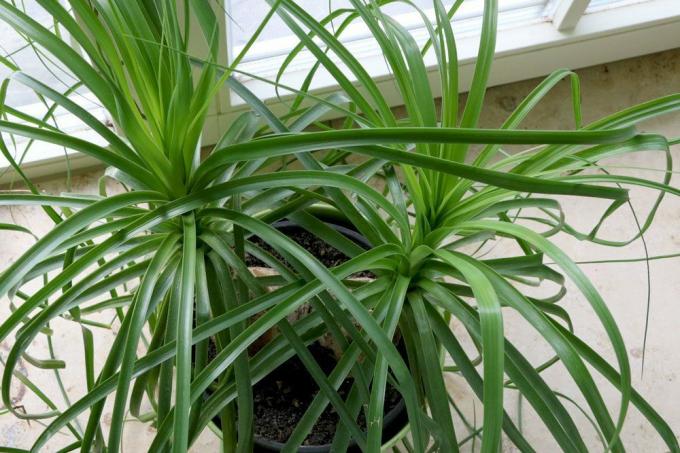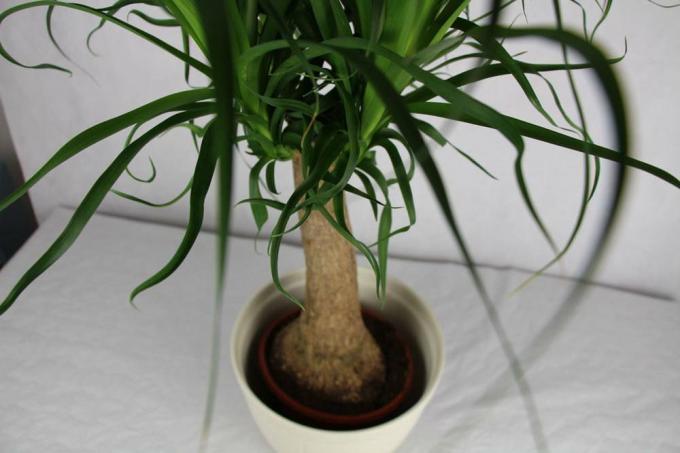
table of contents
- Search for the cause
- Location
- Substrate
- to water
- Fertilize
- Cut
- Instructions for scratching
- frequently asked Questions
Re-sprouting an elephant's foot doesn't have to be difficult. Depending on the cause, simple measures may be sufficient. The instructions show how it can be done.
In a nutshell
- The cause has to be found
- Check and correct care of the elephant foot
- simple measures can help
- radical waste may be required
- Scoring should be a suitable alternative
Search for the cause
Before the appropriate measures can be taken, the cause must first be known why the elephant's foot cannot sprout again. Common problems include:
- Care errors
- Diseases
- Weakened by pests
- wrong location or change of location too quickly
It is therefore worth checking the culture conditions first. Even slight changes can solve the problem and lead to new budding.
Location
The origin of the elephant tree or Beaucarnea, as the plant is called in botanical terminology, lies in the desert. The location of the houseplant should therefore be warm and sunny. If it is too shady, it will hardly sprout, or only very slowly. Even in winter, temperatures should not fall below 10 degrees Celsius. In summer, however, no blazing midday sun should hit the leaves, as they burn quickly, especially behind glass. However, shady trees or curtains and blinds can quickly solve this problem.

Substrate
The soil for the elephant's foot should meet the following factors so that it can sprout well:
- relaxed
- permeable
- moderate nutrient content
Suitable substrates are therefore, for example:
- Cactus soil
- Leaf soil with quartz sand
- Palm soil
- Plant soil with sand or coconut fiber
Tip: Regular repotting prevents the soil from being used up. In addition, diseases and the spread of pests can be prevented.
to water
As a desert plant, the plant does not need much water, but is relatively lime-tolerant. This means that harder tap water can also be used for watering. In addition, watering is only necessary as required. It therefore makes sense to carry out a test beforehand. All you have to do is press your thumb or finger on the ground. If it gives way easily and appears moist, watering is not necessary. If the substrate is dry and firm, watering takes place until the first drops run out of the bottom of the pot. Waterlogging should never occur.
Note: A drainage layer in the lower area of the planter prevents the roots from being in constant contact with the water. In addition, the planter should be checked in order to be able to remove stagnant, excess water in good time.

Fertilize
As a desert plant, the elephant foot not only has an extremely low water requirement. The nutrients can also be used very sparingly. It is completely sufficient to fertilize the plant once in spring and once in summer. A cactus or succulent fertilizer can be used as a means.
Note: So that the roots do not suffer chemical burns, fertilizing should be done together with watering. As a result, the nutrients are distributed evenly in the substrate and are gradually absorbed by the plant.
Cut
If the leaves are damaged, it is necessary to cut them early. This applies, for example, in the following cases:
- kinked leaves
- Burns
- Diseases
- Pest infestation
As soon as discoloration occurs or the leaves dry up, a close inspection should be carried out. This applies to both the culture conditions and the leaves themselves. In this way, for example, pests can be identified, but potential problems can also be discovered at an early stage. If the leaves are largely burned or otherwise damaged, they should be cut radically and the plant moved to a bright spot. Green leaf sections, on the other hand, are to be left on the plant. If all leaves have to be removed, there is a risk that the plant will die. Even small remnants of leafy green can therefore be saved.
Only when the plants sprout again should the old residues be cut off. The following points must be observed:
- use clean cutting tools
- watch out for sharp blades
- create smooth cut surfaces
- Carry out waste as early as possible
- Let the cut surfaces dry well
This reduces the risk of invading pathogens and pests. It is ideal to disinfect the blades of the scissors or knife before and after the cutting tool is used. Cutting off the leaves ensures that the elephant's foot is stimulated to sprout new greens. Alternatively, you can shorten the trunk. In this case, however, it is advisable to also use a wound closure agent.

Instructions for scratching
Another possibility to stimulate the sprouting of new leaves is to scratch the trunk. To do this, you need to make several shallow cuts at the top of the trunk. Here, too, it is important to have a clean cutting tool and sharp blades.
frequently asked Questions
When the plants sprout again depends on the culture conditions. As a rule, growth takes place from spring to late summer. By changing the conditions, however, a more timely expulsion can be achieved.
Yes, the plant is poisonous in all parts. Therefore, children and pets should be kept away from it. Cats and dogs in particular have a tendency to bite and chew on the leaves.
If the houseplant stops sprouting, it may also be due to a lack of light. A plant light then makes sense in any case.
